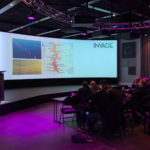“THE WINNER TAKES IT ALL”
By Mari Kristine Buckholm, Smart Innovation Norway 3. November 2017
Head of R&D and Innovation at Lyse, Dagfinn Wåge, explains why it is crucial to discuss new business models early in the project.
“I hope this will not be a project that simply demonstrates new technology in a few pilots and then it is done, because that would mean that we have gotten the business model part wrong”, says Dagfinn Wåge, Head of R&D and Innovation at Lyse and part of the INVADE Project Coordination Committee.
He is happy that there is a whole work package (9) dedicated to ‘new business models and energy market structures’.
Technology vs. business
“But we are working to get this work package done earlier than originally intended, because we want to work parallel to the pilots. We must remember that the pilots are not the goal, they are simply a means to our goal”, explains Wåge. He elaborates:
“Therefore, the pilots should not just be used to demonstrate the technology, they should also be used to demonstrate the business models”.
Wåge makes a point of the fact that many of the stakeholders and companies involved in or affected by INVADE are not necessarily interested in the technology itself; they are interested in doing business.
“A business model describes how you create value, how you distribute the value, and how you capture value with the ones who pay for the product or service. It is a simple three-stage model. I believe business models change the game in a much greater scale than new technology”, states Wåge.
He explains that the best example of this is to take a look at Forbes lists showing the ten most valuable companies in the world. In 2006, the list was dominated by oil companies, banks and insurance companies all using a linear business model.
“Ten years later, six of the old companies have been removed from the list by new companies all using a platform-based business model. And if this wasn’t enough, they have also conquered the top four ranking on the list”, he says.
Engaged in research
Lyse’s Head of R&D and Innovation reveals that his interest in understanding how different business models work, started when he saw a valuation comparison of new internet companies like Google and Apple with large, established telecom actors like AT&T and Verizon in 2011.
“We found that these traditional companies paid big dividends to their owners and shareholders, but the valuation was low. Much lower than with the younger companies, where turnovers were lower and no dividend yield was paid to the owners; everything went back to new research and development of services. We wanted to figure out why”, explains Wåge.
After working with the topic for several years, they concluded that it was the business models that were the game changer. Where the traditional companies rely on so-called one-sided business models, the new companies’ business models are platform-based, also known as multi-sided business models or disruptive ecosystems.
From chain to network
“In the one-sided model, a company sells a product to a customer and gets money back. One thing flows one way, and something else flows back. This is traditional value chain thinking and belongs to the age of the industrial revolution”, comments Wåge.
In contrast, he describes the platform-based business model as a form of value network. In practice, this means that there is no longer just one player who creates value and distributes goods, but many:
“We often come across what we call a two-sided business model, where you have different types of customers on one side and an ecosystem of partners on the other. They often want to innovate with you. Just look at Apple’s App Store; there are several players who develop services, for example the people behind Angry Birds. They have their own company, and even though Apple takes a cut for letting them use their App Store platform, the company gets a direct customer relationship through this platform”.
Prosumers and network effect
Wåge’s point is that this would never happen with the traditional, one-sided business model, where you only see the company you do business with, not the sub-contracting companies contributing to develop the product. In a platform-based business model, sub-contractors become ecosystem partners, enabling them to have a relationship with the end-customers and they also take part in the innovation process, alongside Apple and other players.
Open innovation is then a compulsory part of these new business models, and is enabled via APIs (Application Programming Interface).
“Ecosystem partners can also be prosumers. On the ecosystem side, there can actually be a single individual who creates a new service or app, and all of a sudden he or she is able to reach the whole world. For example, did you know that the first flashlight app on the iPhone was created by a regular Norwegian guy? He became a millionaire over night after crossing over from being a common iPhone user to becoming a producer and ecosystem partner”, says Wåge.

Dagfinn Wåge. LYSE
What he is describing is called the network effect, which can exist on both the customer side and the ecosystem side. The more suppliers there are, the richer the service experience will become for the end-users, which again attracts more end-customers, which again attracts more ecosystem partners, and so on.
“So network effects appear on both sides of the business model, or if we use an energy analogy, this can be referred to as ‘a flying wheel of network effects’.”
Recipe for success
The double-sided network effect makes things accelerate incredibly fast after taking off.
“That is why we say: The winner takes it all. If you are the first to come up with such a platform-based company, you will have a huge opportunity to succeed”, explains Wåge.
He quickly notes that succeeding as a platform entrepreneur requires a great amount of capital:
“In the beginning, everything is about scaling up. You earn nothing and it usually takes a long time before the business becomes profitable, so the investors must have a long term strategy.”
Wåge has written a book on the topic, with the title ‘Creating Disruptive Ecosystems’ (www.disruptiveecosystems.com), and now he wishes to apply his knowledge to explore new platform-based business models in the energy market via the INVADE project.
Learning by doing
“The hard part is transferring the knowledge correctly into the project. It is important that the business model work package also include mapping energy market structures; because the structure is constantly changing and new competitors are entering the market, maybe even through the internet. They can do things that the DSO’s have absolutely no control over, but which creates value to the end-user”, he emphasizes.
Wåge’s objective is to help all the INVADE partners become acquainted with the platform-based business models, what they mean and how they should position themselves in the time to come.
“We believe more players will enter the energy market and that things will happen very fast, which is why we wish to bring the new business models into EU and maybe influence the European Commission. Reports show that the number of companies using a platform-based business model are substantially lower in Europe versus the US and Asia, so it is urgent that we start to emphasize the importance of these new and highly disruptive business models in EU projects and insdustries”.
Social media
INVADE updates

It is possible to control the speed of charging electric cars on a large scale with algorithms. This can be concluded from the results of a Smart Charging test on 700 public charging stations as part of the Horizon 2020 INVADE project. (4 years ago)

“I found the INVADE pilots incredibly interesting”
During the European Utility Week in Paris in November 2019, the INVADE project presented itself in a unique way in the EU Projects Zone. Using videos and an informative quiz, the INVADE stand was always busy. (4 years ago)

“Solutions like INVADE are necessary”
The Horizon 2020 INVADE project is coming to an end this year. Last week, a conference and a workshop were organized on behalf of the project and parallel to event Smart City Expo World Congress in Barcelona. (4 years ago)

The INVADE project has resulted in five successful pilot stories and professional films have been made from each pilot site. You can watch them all here. (4 years ago)

The work package WP9: Business models and market structures, led by INVADE project partner Lyse has put forward a market structure for platform-based business models inspired by disruptive companies like Amazon and Airbnb. (4 years ago)

In the end of May, the INVADE consortium was gathered in the Netherlands. During the two-day meeting, all five pilot owners presented their progress to the project partners. (4 years ago)

Badenova sells and operates networks, energy storages and smart city infrastructures in a region of nearly 1 million inhabitants and adapts INVADE technology and solutions on site for its customers. (4 years ago)

“We will act on everything we have heard today”
When Norway’s Standing Committee on Energy and the Environment visited Smart Innovation Norway headquarters in Halden on Monday, they were introduced to the company’s unique EU research expertise. (5 years ago)

Energy businesses that manage to incorporate total social impact into their activities, products, services, and communication to customers and employees, will have the best premises for future business growth – and for contributing to a better world. (5 years ago)

What is the added value?
In a few weeks the INVADE integrated platform will be up and running and the pilot owners are both hopeful and excited about what the results will show. (5 years ago)